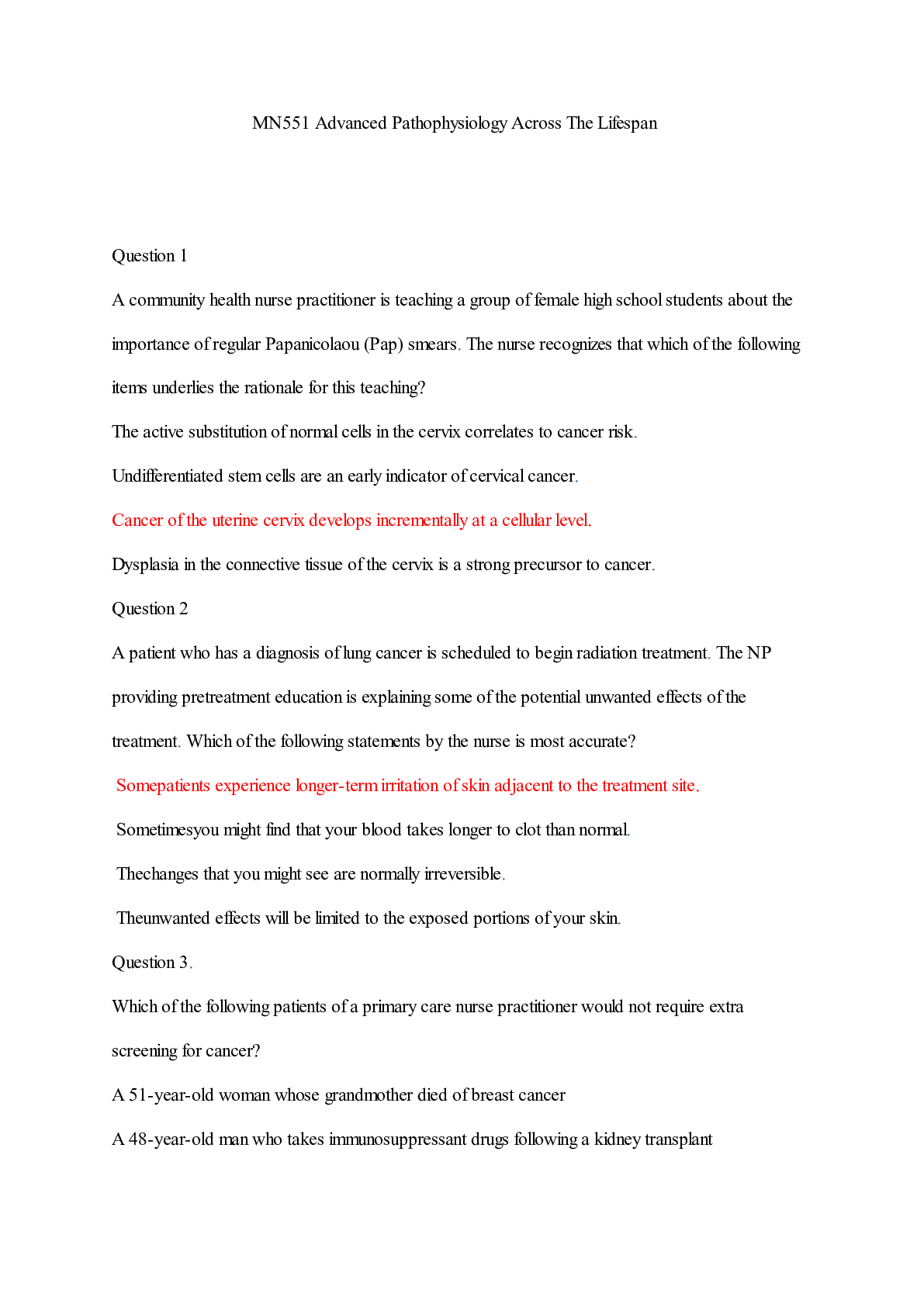MN 551 – Quiz 7 Pathophysiology across the life span.
Document Content and Description Below
MN 551 – Quiz 7 Pathophysiology across the life span Question 1. A 4-year-old boy has had otitis media with effusion (OME) for several weeks and his condition has recently progre... ssed to acute otitis media (AOM). Which of the following factors could have contributed to his AOM? Reflux of fluid from the boy's nose into his middle ear A deficiency in immunoglobulin G Accumulation of cerumen in the external acoustic meatus Sensorineural deficits in the auditory control apparatus Exposure to respiratory syncytial virus (RSV) Question 2. Which of the following statements best captures the role of the adrenal cortex in maintaining homeostasis? The adrenal cortex is responsible for the production of epinephrine and norepinephrine, which are part of the sympathetic nervous system. The adrenal cortical hormones are primarily steroids and sex hormones. Redundant, secondary production of adrenal cortical hormones can compensate for the loss of the adrenal glands. Normal sexual function is dependent on adequate adrenal cortical function. Question 3. A 29-year-old woman has been diagnosed with otosclerosis after several years of progressive hearing loss. What pathophysiologic process has characterized her diagnosis? New, sclerotic / spongy bone has been formed around her stapes and oval window. Her incus, malleus, and stapes have become disconnected from her normal neural pathways. Her temporal bone is experiencing unusually rapid resorption. Her tympanic cavity is becoming filled with bone due to inappropriate osteogenesis. Question 4. A three-year-old girl has just been diagnosed with type 1A diabetes and her parents are currently receiving education from the diabetes education nurse at the hospital where their daughter is receiving treatment. How can the nurse best explain the etiology of their daughter's health problem to her parents? “The problem that underlies her diabetes is that her own body has destroyed the cells in her pancreas that produce insulin.” “It's not known exactly why your daughter has completely stopped making insulin, and treatment will consist of your rigidly controlling her diet.” “This tendency to produce insufficient amounts of insulin is likely something that she inherited.” “Environmental and lifestyle factors are known to play a part in the fact that her pancreas secretes and withholds insulin at the wrong times.” Question 5. An endocrinologist is providing care for a 30-year-old male who has lived with the effects of increased levels of GH. Which of the following teaching points about the patient's future health risks is most accurate? “It's not unusual for unusually high GH levels to cause damage to your hypothalamus.” “GH excess inhibits your pancreas from producing enough insulin.” “The high levels of GH that circulate in your body can result in damage to your liver.” “When your pituitary gland is enlarged, there's a real risk that you'll develop some sight deficiencies. Question 6. Following a long history of fatigue, weakness, and poor appetite, a 39-year-old male has been diagnosed with hypopituitarism. Which of the following clinical findings would most likely cause his care team to suspect that the man has an additional endocrine disorder from a different source? The man has a low sperm count and has been unable to have children. The man has a chronic platelet deficiency and is occasionally anemic. Low platelets and low hemoglobin are unlikely to be a manifestation of hypopituitarism. A low sperm count, small stature, and hypothyroidism are all noted manifestations of pituitary hypofunction. The patient is 5 feet 2 inches tall and was consistently short for his age as a child. The man displays the signs and symptoms of hypothyroidism. Question 7. Which of the following questions is most likely to be clinically useful in the differential diagnosis of sensorineural versus conductive hearing loss? “What medications do you currently take?” “What effect is this hearing loss having on your quality of life?” “Has your hearing loss developed quickly or more slowly?” “Do you ever hear a persistent ringing in your ears?” Question 8. As part of the diagnostic workup for a patient's long-standing vertigo, a clinician wants to gauge the patient's eye movements. Which of the following tests is the clinician most likely to utilize? Romberg test Rotational tests Electronystagmography (ENG) Caloric stimulation Question 9. A 51-year-old woman has been experiencing signs and symptoms of perimenopause and has sought help from her nurse practitioner. Doctors have confirmed a deficiency in estrogen levels as a contributing factor. Which of the following phenomena could potentially underlie the woman's health problem? Sufficient synthesis of estrogen but inadequate vesicle-mediated release Inadequate synthesis in the rough endoplasmic reticulum of her ovarian cells Insufficient estrogen production within the smooth endoplasmic reticulum of the relevant cells A lack of prohormone precursors needed for estrogen synthesis and release Question 10. A woman with a diagnosis of type 2 diabetes has been ordered by her primary care provider to have a hemoglobin A1C test for the first time. The woman states, “I don't see why you want to test my blood cells when it's sugar that's the problem.” What aspect of physiology will underlie the care provider's response to the patient? The amount of glucose attached to A1C cells reflects the average blood glucose levels over the life of the cell. Hemoglobin synthesis by the bone marrow is inversely proportionate to blood glucose levels, with low A1C indicating hyperglycemia. The high metabolic needs of red cells and their affinity for free glucose indicate the amount of glucose that has been available over 6 to 12 weeks. Insulin is a glucose receptor agonist on the hemoglobin molecule, and high glucose suggests low insulin levels. Question 11. A 46-year-old male has presented to the emergency department because of the eye pain, severe headache, and blurred vision that have followed an eye exam at an optometrist's office earlier in the day. The patient tells the triage nurse that he received eyedrops during the exam “to keep my pupils wide open.” What differential diagnosis will the care team first suspect? Infectious conjunctivitis Keratitis Corneal trauma Angle-closure glaucoma Question 12. A 28-year-old male who is 6 feet 11 inches tall has a diagnosis of acromegaly. The man is explaining to a curious but sympathetic coworker exactly what accounts for his extraordinary height. Which of the following explanations demonstrates a sound understanding of his health problem? “My pituitary gland produced a much higher than normal amount of growth hormone when I was a child.” “A tumor in my brain threw off my hormone levels after I was finished with adolescence.” “My liver is malfunctioning and produces too many of the hormones that ultimately cause growth.” T“The high sugar levels that go along with my diabetes made my pituitary gland overproduce the hormones that cause you to grow.” Question 13. A stroke affecting which of the following areas of the brain would be most likely to leave an individual's vestibular system intact and posture and balance maintained? The brain stem The thalamus The temporal and parietal cortex The limbic system of the cerebrum Question14. Which of the following statements best captures an aspect of the role of hormones in the body? Some chemical substances can function as either hormones or neurotransmitters. Hormones directly initiate many of the processes that contribute to homeostasis. Control of body processes is ensured by the fact that a single hormone can only exert one effect on one specific system or tissue. Each hormone that exists in the body is produced by only one specific endocrine gland. Question15. A 60-year-old man has presented to his nurse practitioner because of an earache that has become progressively more painful in recent days. After giving his history and having an examination with an otoscope, the man has been diagnosed with otitis externa. Which of the nurse practitioner's following statements to the man is most accurate? “You'll need to avoid getting any water in your ear until you finish your course of antibiotic pills.” “I'm going to instill some warm water into your ear to flush out debris and bacteria.” “I'll prescribe some ear drops for you, and in the meantime it's important not to use ear swabs.” “This likely happened because your ears aren't draining like they should, but antibiotics that you'll put in your ears will resolve this.” Question 16. A 30-year-old man with a diagnosis of type 1 diabetes is aware of the multiple effects that insulin has on his metabolism. Which of the following physiological processes are actions of insulin? Decreasing glucose transport to skeletal muscles Promoting the breakdown of stored triglycerides Facilitating triglycerides from glucose in fat cells Inhibiting protein breakdown Promoting glucose uptake by target cells Question 17. During descent, an airplane passenger is complaining that his “ears are plugged.” What aspect of the structure and function of the ear best accounts for the passenger's complaint? The inner ear adjusts its volume in response to atmospheric pressure, increasing during low pressure and decreasing in high pressure. The eustachian tubes must remain patent to equalize pressure between the middle ear and inner ear. The tympanic membrane is selectively permeable in order to accommodate pressure changes and this capacity is often impaired during upper respiratory infections. Air must be able to flow between the middle ear and the nasopharynx in order to accommodate pressure changes. Queston 26 Following a long history of faTgue, weakness, and poor appeTte, a 39-year-old male has been diagnosed with hypopituitarism. Which of the following clinical Fndings would most likely cause his care team to suspect that the man has an addiTonal endocrine disorder from a diµerent source? Queston 27 Which of the following best describes the half-life of a highly protein-bound drug such as thyroxine (99% protein bound)? ²he half-life would be Queston 28 A 21-year-old female is suspected of having inadequate funcTon of her hypothalamic –pituitary–thyroid system. Her care provider is planning to inject thyrotropin-releasing hormone (TRH) and then measure her levels of TSH. Which of the following diagnostic tests is being performed? Question 29 Following the identification of low blood levels of corTisol and low 24-hour urinary free corTsol, a 51-year-old female client has been diagnosed with a primary adrenal corTtcal insufficiency. Which of the following health consequences would be a³ributable to her low levels of corTsol? Queston 30 A medical student is scheduled to undergo a clinical exam of his assessment skills under the supervision of the a³ending physician. As a result of this stressor, the student has high serum levels of glucocorTcoid hormones such as corTsol. Which of the following statements best captures an aspect of the role o± glucocorTcoid hormones such as corTsol in the physiological response to stress? Queston 31 Following a meal, a woman's blood glucose level has increased. In addition, her pancreas has increased the amount of insulin produced and released. Which of the following phenomena has occurred? Queston 32 Since steroid hormones are bound to protein carriers for transport, this means: Queston 33 Which of the following statements best captures an aspect of the ±uncTon of the hypothalamic –pituitary– adrenal (HPA) system? A patient with a new diagnosis of an endocrine disorder is unclear about how the body can control the levels of different hormones over time. Which of the following statements most accurately underlies the dominant regulation process of hormone levels in the body? A) A positive feedback cycle ensures that stable levels of hormones exist in the body over time. B) With input from various sensors, hormone production and release are adjusted based on existing hormone levels. C) The hypothalamus ensures that hormone levels correspond accurately to the diurnal cycle. D) The pituitary gland is genetically programmed to stimulate and inhibit hormone production and/or release based on needs at different points in the life cycle 13. A 21-year-old female is suspected of having inadequate function of her hypothalamic–pituitary–thyroid system. Her care provider is planning to inject thyrotropin-releasing hormone (TRH) and then measure her levels of TSH. Which of the following diagnostic tests is being performed? A)Suppression test B)Radioimmunoassay (RIA) test C)Stimulation test D)Metabolite excretion test 14. Following a meal, a woman's blood glucose level has increased. In addition, her pancreas has increased the amount of insulin produced and released. Which of the following phenomena has occurred? A) Increased hormone level according to a negative feedback mechanism B) Adjustment according to the level of the substance a hormone regulates C)Hormone production and release via the positive feedback cycle D)Hypothalamic–pituitary control of hormone levels 15.Which of the following statements best captures the relationship between the hypothalamus and the pituitary gland as it relates to endocrine function? A) The hypothalamus directly measures the levels of most hormones throughout the body and inhibits or stimulates the pituitary accordingly. B) The pituitary gland coordinates and dictates the release of hormones from the hypothalamus that act on their intended target cells. C) The pituitary gland and hypothalamus have two-way communication that mediates the signals from neuronal inputs. D)The hypothalamus receives input from numerous sources throughout the body and directs the pituitary to then control many target glands and cells. 8. An endocrinologist is providing care for a 30-year-old male who has lived with the effects of increased levels of growth hormone (GH). Which of the following teaching points about the client's future health risks is most accurate? A)“It's not unusual for high GH levels to cause damage to your hypothalamus.” B)“GH excess inhibits your pancreas from producing enough insulin.” C)“The high levels of GH that circulate in your body can result in damage to your liver.” D)“When your pituitary gland is enlarged, there's a real risk that you'll develop some sight deficiencies.” Ans D Feedback: GH excess is associated with tumor formation and consequent compression of cranial nerves responsible for vision. Damage to the hypothalamus and liver is not common sequelae. While the beta cells of the pancreas can “burn out,” the primary effect of excessGH is to increase insulin secretion. Question 1.1. A three-year-old girl has just been diagnosed with type 1A diabetes and her parents are currently receiving education from the diabetes education nurse at the hospital where their daughter is receiving treatment. How can the nurse best explain the etiology of their daughter's health problem to her parents? "The problem that underlies her diabetes is that her own body has destroyed the cells in her pancreas that produce insulin." "It's not known exactly why your daughter has completely stopped making insulin, and treatment will consist of your rigidly controlling her diet." "This tendency to produce insufficient amounts of insulin is likely something that she inherited." "Environmental and lifestyle factors are known to play a part in the fact that her pancreas secretes and withholds insulin at the wrong times." Question 2. A 60-year-old man has presented to his nurse practitioner because of an earache that has become progressively more painful in recent days. After giving his history and having an examination with an otoscope, the man has been diagnosed with otitis externa. Which of the nurse practitioner's following statements to the man is most accurate? "You'll need to avoid getting any water in your ear until you finish your course of antibiotic pills." "I'm going to instill some warm water into your ear to flush out debris and bacteria." "I'll prescribe some ear drops for you, and in the meantime it's important not to use ear swabs." "This likely happened because your ears aren't draining like they should, but antibiotics that you'll put in your ears will resolve this." Question 3. A patient with a new diagnosis of an endocrine disorder is unclear about how the body can control the levels of different hormones over time. Which of the following statements most accurately underlies the dominant regulation process of hormone levels in the body? A positive feedback cycle ensures that stable levels of hormones exist in the body over time. With input from various sensors, hormone production and release are adjusted based on existing hormone levels. The hypothalamus ensures that hormone levels correspond accurately to the diurnal cycle. The pituitary gland is genetically programmed to stimulate and inhibit hormone production and/or release based on needs at different points in the life cycle. Question 4. What does a high level of thyroid-stimulating hormone indicate? Hypothyroidism Myxedema Hyperthyroidism Thyroid nodule 5. Following the identification of low levels of T3 and T4 coupled with the presence of a goiter, a 28-year-old female has been diagnosed with Hashimoto thyroiditis. In light of this diagnosis, which of the following assessment results would constitute an unexpected finding? The presence of myxedema in the woman's face and extremities Recent weight gain despite a loss of appetite and chronic fatigue Coarse, dry skin and hair with decreased sweat production Increased white cell count and audible crackles on chest auscultation 6. A stroke affecting which of the following areas of the brain would be most likely to leave an individual's vestibular system intact and posture and balance maintained? The brain stem The thalamus The temporal and parietal cortex The limbic system of the Question 7. A care aide at a long-term care facility has informed a resident's nurse practitioner that the 80-year-old woman's eyes appear to be inflamed and her eyelids are caked with sticky secretions. The woman subsequently has been diagnosed with posterior blepharitis. Which of the following treatments is the nurse practitioner likely to initiate? Surgical repair of the woman's blocked meibomian glands Warm compresses to be applied regularly to her eyes in addition to oral antibiotics Regularly scheduled cleansing of the woman's eyes with normal saline Intravenous steroids coupled with topical antibiotic ointment Question 8. An endocrinologist is providing care for a 30-year-old male who has lived with the effects of increased levels of GH. Which of the following teaching points about the patient's future health risks is most accurate? "It's not unusual for unusually high GH levels to cause damage to your hypothalamus." "GH excess inhibits your pancreas from producing enough insulin." "The high levels of GH that circulate in your body can result in damage to your liver." "When your pituitary gland is enlarged, there's a real risk that you'll develop some sight deficiencies. Question 9. A 46-year-old male has presented to the emergency department because of the eye pain, severe headache, and blurred vision that have followed an eye exam at an optometrist's office earlier in the day. The patient tells the triage nurse that he received eyedrops during the exam "to keep my pupils wide open." What differential diagnosis will the care team first suspect? Infectious conjunctivitis Keratitis Corneal trauma Angle-closure glaucoma Question 10. A patient with a history of an endocrine disorder exhibits signs and symptoms of hormone deficiency. Which of the following processes would the patient's care team most likely rule out first as a contributing factor? The patient's target cells lack sufficient receptors for the hormone in question. Hormone production is sufficient, but affinity on the part of the target cells is lacking. The process of down-regulation has resulted in decreased hormone sensitivity. Up-regulation has increased the sensitivity of the body to particular hormone levels. Question 11. A 51-year-old woman has been experiencing signs and symptoms of perimenopause and has sought help from her nurse practitioner. Doctors have confirmed a deficiency in estrogen levels as a contributing factor. Which of the following phenomena could potentially underlie the woman's health problem? Sufficient synthesis of estrogen but inadequate vesicle-mediated release Inadequate synthesis in the rough endoplasmic reticulum of her ovarian cells Insufficient estrogen production within the smooth endoplasmic reticulum of the relevant cells A lack of prohormone precursors needed for estrogen synthesis and release 12. Which of the following hormones are derivatives of cholesterol? Epinephrine and norepinephrine Insulin and glucagon Aldosterone and testosterone Eicosanoids and retinoids Question 13. A 32-year-old man is complaining of burning, itching, photophobia, and severe pain in his right eye after swimming in the ocean. To determine that the eye condition is corneal rather than a conjunctival disease, which of the following would be the distinguishing symptom? Burning Itching Photophobia Severe pain Question 14. 14. As part of the diagnostic workup for a patient’s long-standing vertigo, a clinician wants to gauge the patient’s eye movements. Which of the following tests is the clinician most likely to utilize? (Points : 0.4) Romberg test Rotational tests Electronystagmography (ENG) Caloric stimulation Question 15. 15. A woman with a diagnosis of type 2 diabetes has been ordered by her primary care provider to have a hemoglobin A1C test for the first time. The woman states, “I don’t see why you want to test my blood cells when it’s sugar that’s the problem.” What aspect of physiology will underlie the care provider’s response to the patient? (Points : 0.4) The amount of glucose attached to A1C cells reflects the average blood glucose levels over the life of the cell. Hemoglobin synthesis by the bone marrow is inversely proportionate to blood glucose levels, with low A1C indicating hyperglycemia. The high metabolic needs of red cells and their affinity for free glucose indicate the amount of glucose that has been available over 6 to 12 weeks. Insulin is a glucose receptor agonist on the hemoglobin molecule, and high glucose suggests low insulin levels. Question 16. 16. A patient with a new diagnosis of an endocrine disorder is unclear about how the body can control the levels of different hormones over time. Which of the following statements most accurately underlies the dominant regulation process of hormone levels in the body? (Points : 0.4) A positive feedback cycle ensures that stable levels of hormones exist in the body over time. The hypothalamus ensures that hormone levels correspond accurately to the diurnal cycle. The pituitary gland is genetically programmed to stimulate and inhibit hormone production and/or release based on needs at different points in the life cycle. Question 17. 17. Large amounts of glucagon were recently released into an individual’s circulation, but glucagon circulation has now ceased. Which of the following situations could have led to this inhibition of glucagon release? A sharp decrease in blood glucose concentration Recent strenuous physical activity Recent intake of large amounts of protein-rich food A decrease in cellular metabolic needs and an increase in glucose levels Question 18. 18. Following a long history of fatigue, weakness, and poor appetite, a 39-year-old male has been diagnosed with hypopituitarism. Which of the following clinical findings would most likely cause his care team to suspect that the man has an additional endocrine disorder from a different source? (Points : 0.4) The man has a low sperm count and has been unable to have children. The man has a chronic platelet deficiency and is occasionally anemic. The patient is 5 feet 2 inches tall and was consistently short for his age as a child. The man displays the signs and symptoms of hypothyroidism. Question 19. 19. Which of the following statements best captures an aspect of the role of hormones in the body? Some chemical substances can function as either hormones or neurotransmitters. Hormones directly initiate many of the processes that contribute to homeostasis. Control of body processes is ensured by the fact that a single hormone can only exert one effect on one specific system or tissue. Each hormone that exists in the body is produced by only one specific endocrine gland. Question 20. 20. Which of the following hormones are derivatives of cholesterol? (Points : 0.4) Epinephrine and norepinephrine Insulin and glucagon Aldosterone and testosterone Eicosanoids and retinoids Question 21. 21. A 21-year-old female is suspected of having inadequate function of her hypothalamic-pituitary-thyroid system. Her care provider is planning to inject thyrotropin-releasing hormone (TRH) and then measure her levels of TSH. Which of the following diagnostic tests is being performed? Suppression test Radioimmunoassay (RIA) test Stimulation test Metabolite excretion test Question 22. 22. An endocrinologist is providing care for a 30-year-old male who has lived with the effects of increased levels of GH. Which of the following teaching points about the patient’s future health risks is most accurate? (Points : 0.4) “It’s not unusual for unusually high GH levels to cause damage to your hypothalamus. “GH excess inhibits your pancreas from producing enough insulin. “The high levels of GH that circulate in your body can result in damage to your liver.” “When your pituitary gland is enlarged, there’s a real risk that you’ll develop some sight deficiencies. Question 23. 23. A three-year-old girl has been diagnosed with amblyopia. Which of the following pathophysiologic processes is most likely to underlie her health problem? The child may have a congenital deficit of rods and/or cones The girl may have chronic bacterial conjunctivitis She may have been born with infantile cataracts The child may have a neural pathway disorder Question 24. 24. A 60-year-old man has presented to his nurse practitioner because of an earache that has become progressively more painful in recent days. After giving his history and having an examination with an otoscope, the man has been diagnosed with otitis externa. Which of the nurse practitioner’s following statements to the man is most accurate? (Points : 0.4) “You’ll need to avoid getting any water in your ear until you finish your course of antibiotic pills.” “I’m going to instill some warm water into your ear to flush out debris and bacteria.” “I’ll prescribe some ear drops for you, and in the mean time it’s important not to use ear swabs.” “This likely happened because your ears aren’t draining like they should, but antibiotics that you’ll put in your ears will resolve this.” Question 25. 25. Which of the following statements best describes an aspect of the normal process of glucose metabolism? (Points : 0.4) a. Blood glucose levels are primarily a result of the timing, quantity, and character of food intake. b. Ingested glucose that is not needed for cellular metabolism circulates in the blood until it is taken up to meet cellular needs. c.Blood glucose levels are kept in a steady state by selective excretion and reuptake by the kidneys. d.Glucose that exceeds metabolic needs is converted and stored by the liver. A 30 yo woman has sought care because of her recurrent photophobia, tearing and eye irritation. During assessment, her care provider asks about any history of cold sores or genital herpes. What is the rationale for the care provider’s line of questioning? Which of the following statements best captures the role of the adrenal cortex in maintaining homeostasis? [Show More]
Last updated: 2 years ago
Preview 1 out of 23 pages

Buy this document to get the full access instantly
Instant Download Access after purchase
Buy NowInstant download
We Accept:

Reviews( 0 )
$15.00
Can't find what you want? Try our AI powered Search
Document information
Connected school, study & course
About the document
Uploaded On
Apr 12, 2020
Number of pages
23
Written in
Additional information
This document has been written for:
Uploaded
Apr 12, 2020
Downloads
0
Views
85












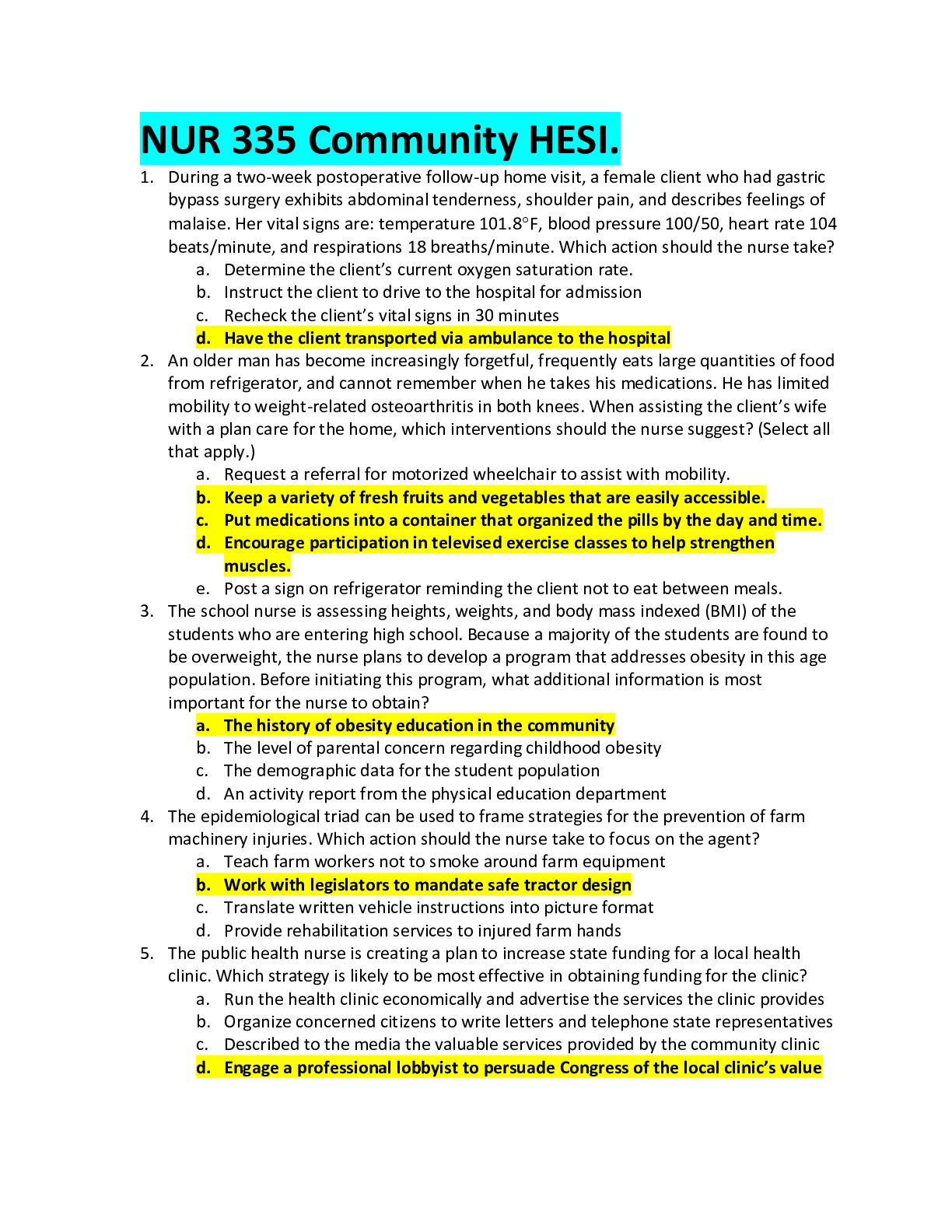


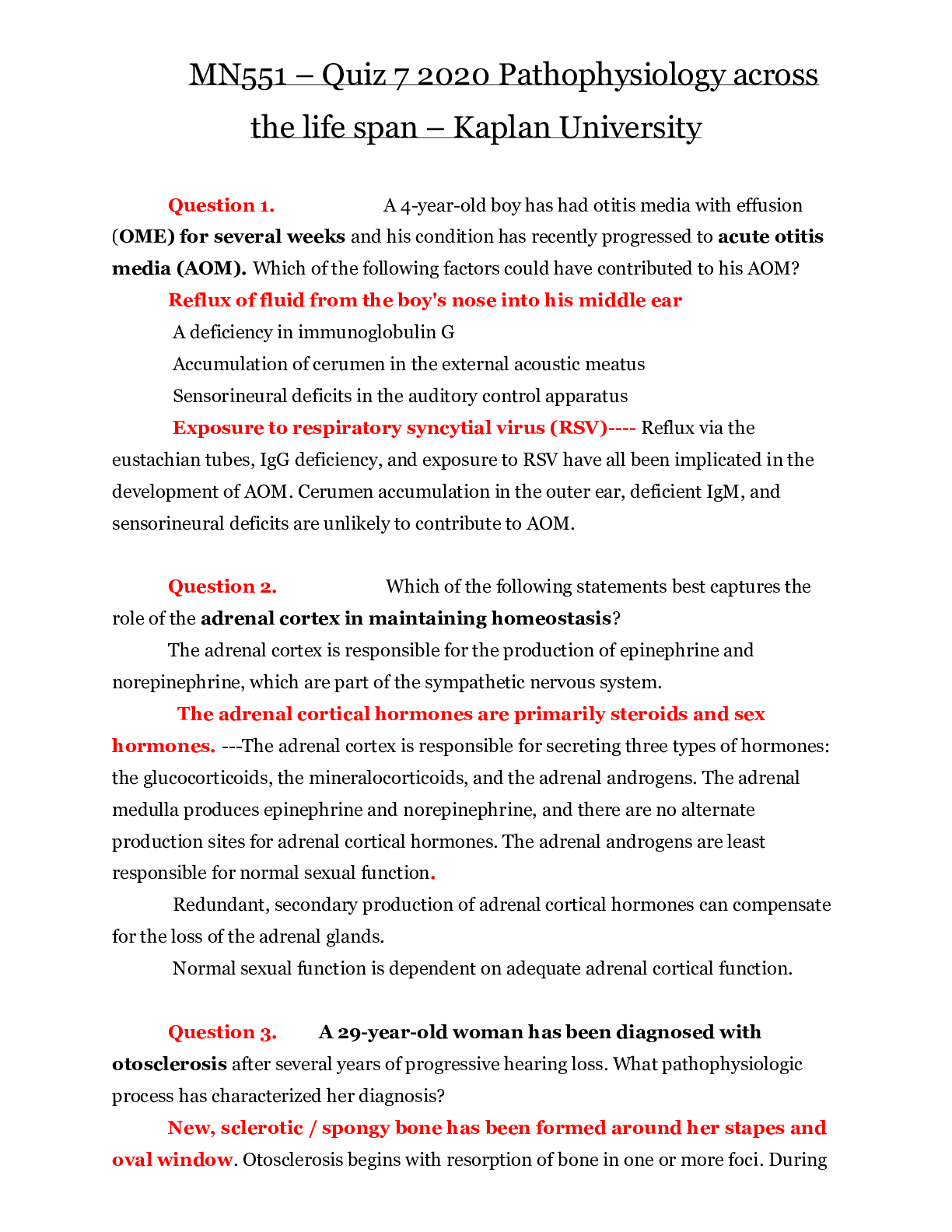


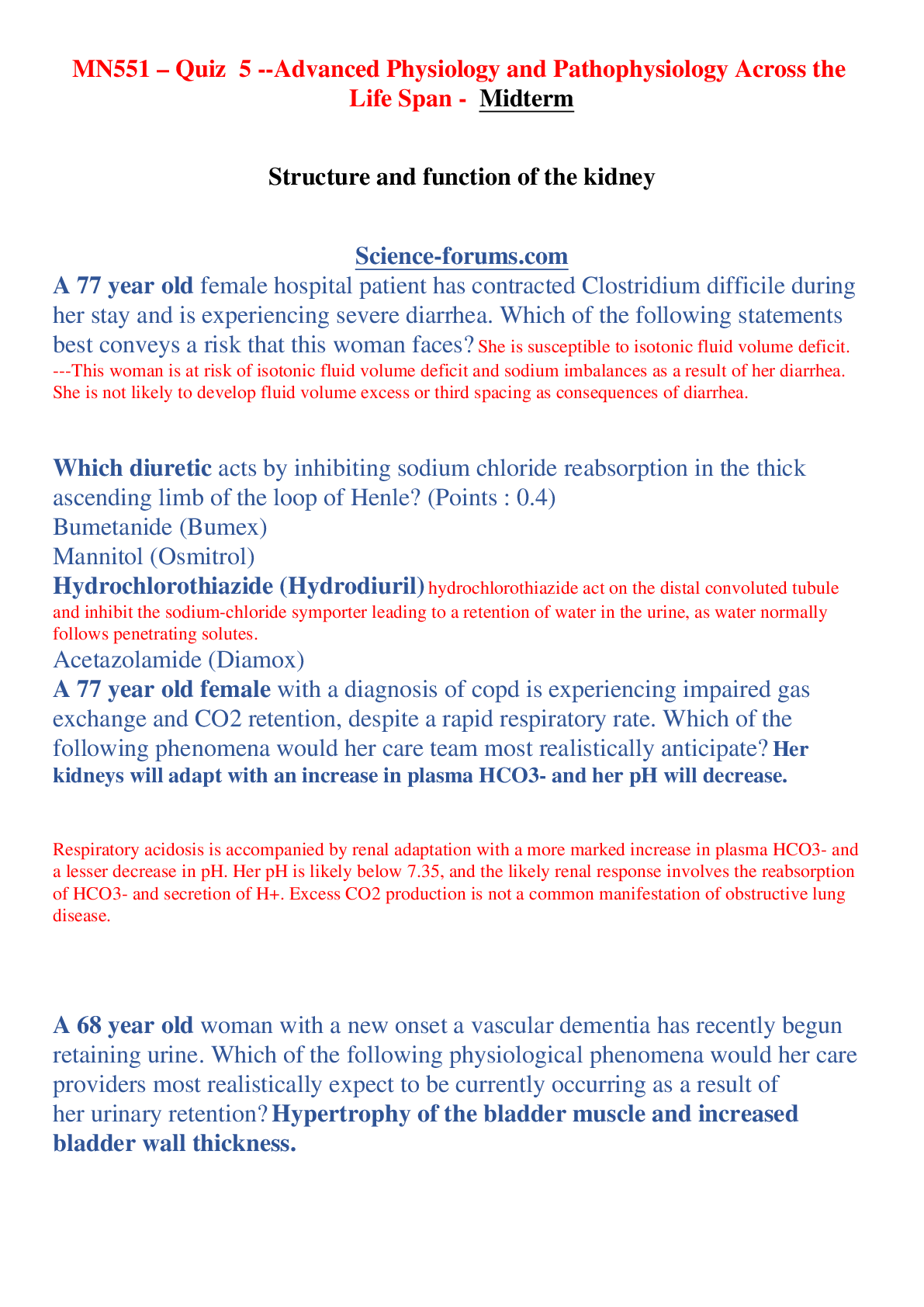

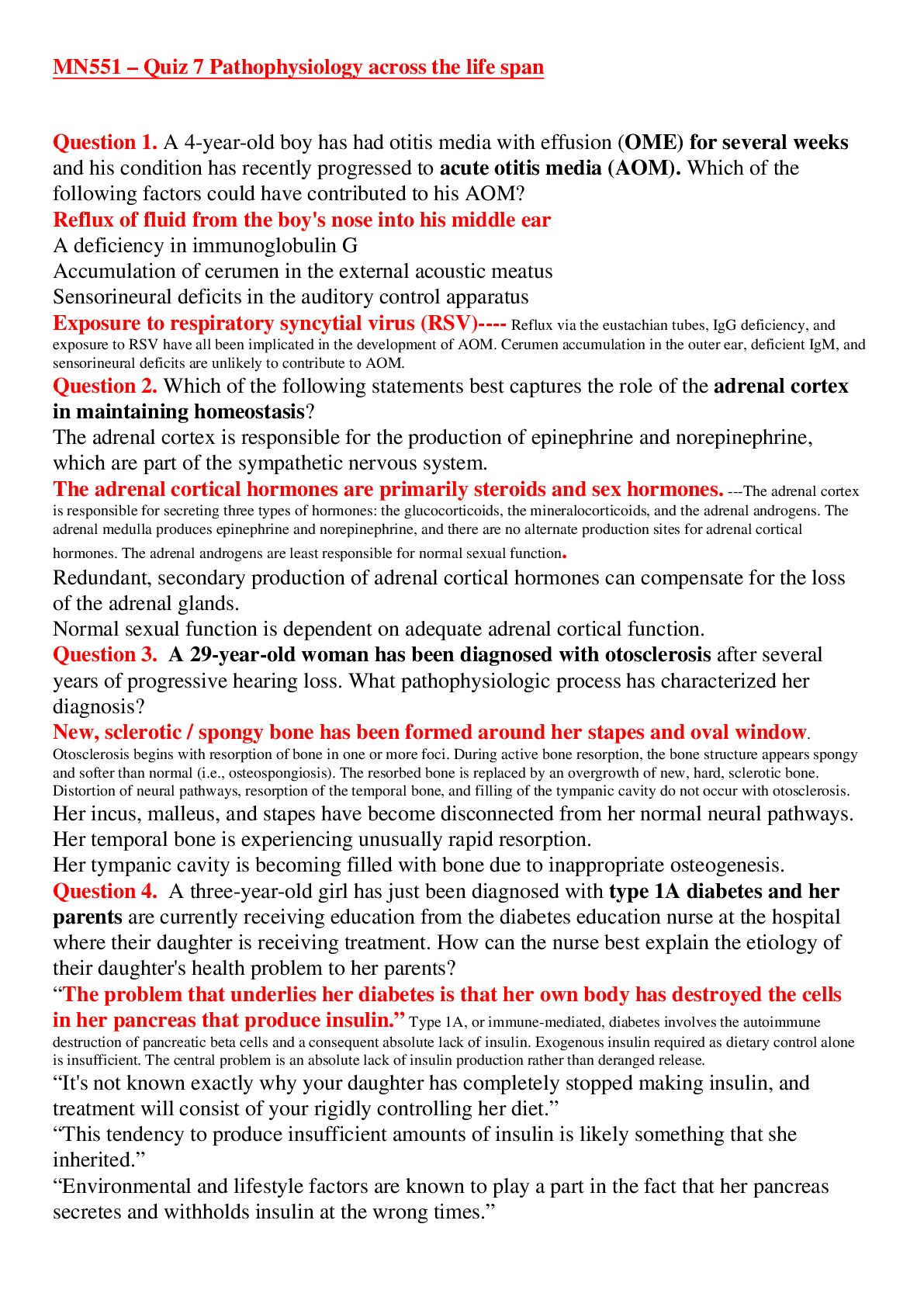
.png)
